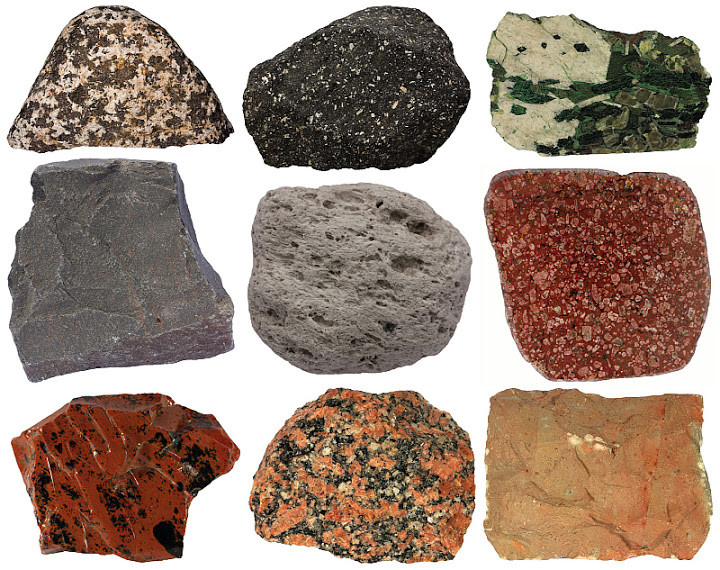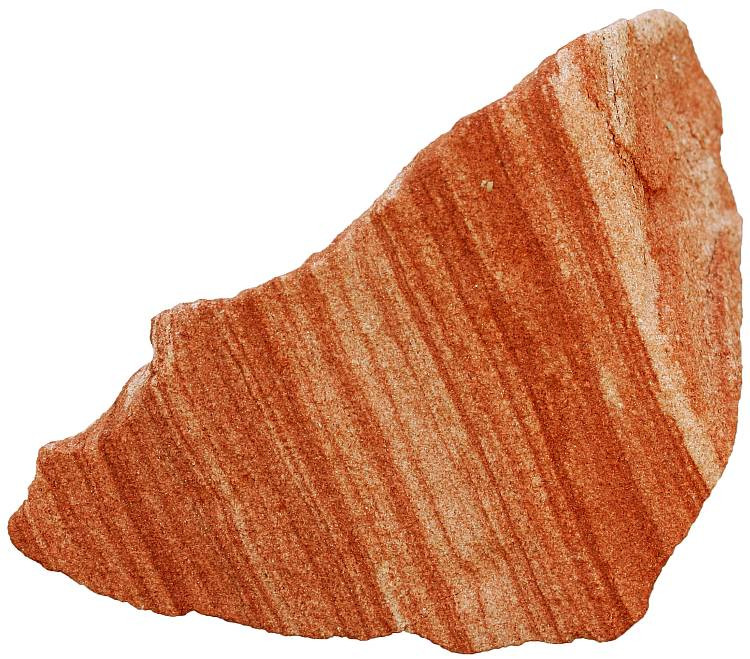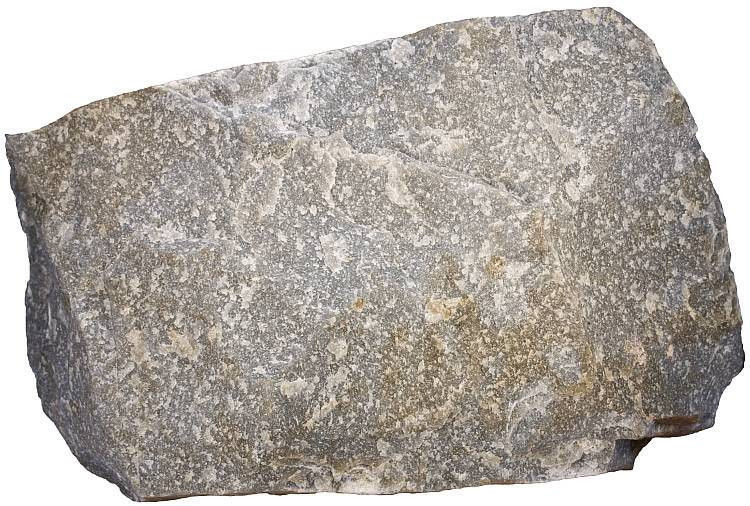A List Of Rocks is a comprehensive compilation of different rock types, each possessing unique characteristics and applications. At rockscapes.net, we understand that choosing the right rocks is crucial for creating stunning and sustainable landscapes. Let’s explore the diverse world of rocks and how they can transform your outdoor spaces.
1. Understanding the Three Major Rock Types
Rocks are naturally occurring solid aggregates of one or more minerals. Geologists classify rocks into three main categories based on their formation processes: igneous, sedimentary, and metamorphic.
- Igneous Rocks: Formed from the cooling and solidification of molten rock (magma or lava).
- Sedimentary Rocks: Formed from the accumulation and cementation of sediments, such as mineral grains, rock fragments, and organic matter.
- Metamorphic Rocks: Formed when existing rocks are transformed by heat, pressure, or chemical reactions.
2. Why Is Knowing a List of Rocks Important for Landscaping?
Knowing the different types of rocks is essential for anyone involved in landscaping, from homeowners to professional designers and contractors. Here’s why:
- Aesthetic Appeal: Different rocks offer a wide range of colors, textures, and patterns, allowing you to create visually appealing and unique landscapes.
- Functionality: Rocks can serve various functional purposes, such as erosion control, drainage, pathways, and retaining walls.
- Sustainability: Using locally sourced rocks can reduce transportation costs and environmental impact.
- Durability: Rocks are durable and long-lasting materials that can withstand harsh weather conditions.
- Property Value: Well-designed rockscapes can enhance the value and curb appeal of your property.
3. A Comprehensive List of Rocks for Landscaping
Here’s a detailed list of rocks commonly used in landscaping, categorized by their type:
3.1. Igneous Rocks
Igneous rocks are known for their durability and unique textures, making them ideal for various landscaping applications.
| Rock Type | Description | Landscaping Uses |
|---|---|---|
| Granite | A coarse-grained, light-colored rock composed mainly of quartz and feldspar. Known for its strength and resistance to weathering. | Retaining walls, pathways, patios, decorative boulders, rock gardens. |
| Basalt | A dark-colored, fine-grained rock commonly used in paving and wall construction. Offers a modern and sleek appearance. | Pathways, paving stones, retaining walls, water features. |
| Lava Rock | A porous, lightweight rock formed from volcanic eruptions. Excellent for drainage and adding texture to landscapes. | Mulch, rock gardens, planters, fire pits, water features. |
| Pumice | A very light and porous volcanic rock, often used in soil mixes to improve drainage and aeration. | Soil amendment, planters, lightweight aggregate. |
| Obsidian | A volcanic glass with a smooth, glassy texture and typically dark color. Used for decorative purposes and in specialized garden designs. | Decorative accents, rock gardens, unique landscaping features. |
| Andesite | Volcanic rock with an average composition, it is more felsic than basalt and more mafic than dacite. Generally dark gray and may contain phenocrysts. | Rock gardens, retaining walls, decorative stone. |
| Pegmatite | An exceptionally coarse-grained plutonic rock. Most pegmatites have a granitic composition and contain common minerals like feldspar, mica and quartz. | Decorative accents, unique landscaping features. |
| Scoria | A highly vesicular mafic dark-colored volcanic rock, similar to pumice but darker in color and more mafic in composition. | Mulch, rock gardens, drainage. |
 Igneous rock samples
Igneous rock samples
3.2. Sedimentary Rocks
Sedimentary rocks offer a wide variety of textures and colors, making them popular for landscaping.
| Rock Type | Description | Landscaping Uses |
|---|---|---|
| Sandstone | A sedimentary rock composed of sand-sized grains of minerals, rock fragments, or organic material. Available in various colors and textures. | Paving stones, retaining walls, pathways, decorative accents, rock gardens. |
| Limestone | A sedimentary rock composed primarily of calcium carbonate. Often used for walls, pathways, and decorative features. | Retaining walls, pathways, patios, decorative boulders, rock gardens. |
| Flagstone | A type of sedimentary rock, typically sandstone or slate, that is easily split into flat slabs. Ideal for paving and creating natural-looking pathways. | Patios, pathways, stepping stones, wall cladding. |
| River Rock | Smooth, rounded stones found in riverbeds. Available in various sizes and colors. Commonly used for drainage, decorative ground cover, and water features. | Drainage, ground cover, water features, decorative accents, dry creek beds. |
| Gravel | Small, loose rock fragments used for pathways, driveways, and drainage. Available in various sizes and colors. | Pathways, driveways, drainage, ground cover. |
| Shale | A laminated rock consisting of mostly clay minerals. Shale and similar mudstones make up more than half of all the sedimentary rocks and is a source rock of crude oil and natural gas. | Accents for a rustic design. |
| Conglomerate | A lithified gravel (rounded rock fragments or mineral grains larger than 2 mm in size), used as a disintegration product of nearby granitic rocks, very durable. | Retaining walls, pathways, patios, decorative accents, rock gardens. |
| Coquina | A detrital limestone consisting of shells or shell fragments. Coquina is a coarse-grained conglomeratic rock and offers accents in unique designs. | Rock gardens, retaining walls, decorative stone. |
 Sandstone
Sandstone
3.3. Metamorphic Rocks
Metamorphic rocks are known for their unique textures and patterns, adding elegance to any landscape.
| Rock Type | Description | Landscaping Uses |
|---|---|---|
| Slate | A fine-grained metamorphic rock that can be split into thin, flat sheets. Commonly used for roofing, paving, and wall cladding. | Roofing, paving, wall cladding, pathways, decorative accents. |
| Marble | A metamorphic rock composed of recrystallized carbonate minerals, most commonly calcite or dolomite. Prized for its beauty and used in decorative applications. | Decorative accents, sculptures, countertops, wall cladding, water features. |
| Quartzite | A metamorphic rock composed primarily of quartz. Known for its hardness and resistance to weathering. | Retaining walls, pathways, patios, decorative boulders, rock gardens. |
| Gneiss | A banded metamorphic rock with distinct layers of minerals. Adds visual interest to landscapes with its unique patterns. | Retaining walls, decorative boulders, rock gardens, pathways. |
| Schist | A strongly foliated metamorphic rock rich in platy or elongated minerals. Schist forms during regional metamorphism and can be used as an eye-catching accent piece. | Retaining walls, decorative boulders, rock gardens, pathways. |
| Serpentinite | A metamorphosed ultramafic rock and composed of serpentine minerals. Chlorite, talc and magnesite frequently occur in these rocks and can be used for rock accents. | Rock accents in gardens. |
 Quartzite
Quartzite
4. Landscaping Ideas and Inspiration
Here are some landscaping ideas using different types of rocks:
- Rock Gardens: Create a stunning rock garden with a variety of igneous, sedimentary, and metamorphic rocks, complemented by drought-tolerant plants.
- Water Features: Use river rocks and lava rocks to create natural-looking waterfalls, ponds, and streams.
- Pathways: Construct pathways with flagstone, sandstone, or gravel for a functional and aesthetically pleasing landscape.
- Retaining Walls: Build retaining walls with granite, limestone, or quartzite to prevent erosion and create terraced gardens.
- Decorative Accents: Add decorative accents with marble sculptures, obsidian stones, or gneiss boulders to enhance the visual appeal of your landscape.
5. Factors to Consider When Choosing Rocks
When selecting rocks for your landscaping project, consider the following factors:
- Climate: Choose rocks that are resistant to weathering and can withstand the specific climate conditions in your area. According to research from Arizona State University’s School of Earth and Space Exploration, in July 2025, certain rock types provide better insulation against extreme heat.
- Soil Type: Consider the soil type in your garden and choose rocks that complement the soil’s pH and drainage properties.
- Aesthetic Preferences: Select rocks that match your personal style and the overall design of your landscape.
- Budget: Determine your budget and choose rocks that fit within your financial constraints.
- Availability: Source rocks from local suppliers to reduce transportation costs and environmental impact.
6. Sourcing Rocks in the USA
In the USA, rocks can be sourced from various suppliers, including:
- Local Quarries: Offer a wide selection of natural stones and aggregates.
- Landscape Supply Stores: Provide a variety of rocks, gravel, and decorative stones.
- Home Improvement Centers: Carry basic landscaping rocks and materials.
- Online Retailers: Offer a convenient way to purchase rocks and have them delivered to your doorstep.
6.1. Common Types of Rocks Used in Landscaping in Arizona (USA)
Arizona’s unique desert environment calls for specific rock selections. Here are some popular choices:
- Quartzite: Its durability and heat resistance make it ideal for pathways and retaining walls.
- Flagstone: Perfect for patios and walkways, blending seamlessly with the natural desert landscape.
- River Rock: Adds a touch of natural beauty to water features and dry creek beds.
- Lava Rock: Its porous nature aids in drainage and provides a striking contrast in desert gardens.
Remember to consider the color and texture of the rocks to match your landscaping style.
6.2. Where to Find These Rocks in Arizona
- Local Quarries: Companies like Arizona Stone supply a wide variety of rocks suitable for landscaping.
- Landscape Supply Stores: Check out local suppliers like Pioneer Sand Company for various rock options.
- Online Retailers: Online stores such as Amazon offer various rock types with delivery options.
7. How to Install Rocks in Your Landscape
Installing rocks in your landscape requires careful planning and execution. Here are some general steps:
- Prepare the Site: Clear the area of vegetation, debris, and any existing structures.
- Plan the Layout: Design the layout of your rockscape, considering the size, shape, and placement of the rocks.
- Install Base Materials: Add a layer of gravel or crushed stone to provide a stable base for the rocks.
- Place the Rocks: Carefully position the rocks according to your design, ensuring they are stable and secure.
- Fill Gaps: Fill the gaps between the rocks with soil, gravel, or other materials to create a cohesive and natural look.
- Add Plants: Incorporate drought-tolerant plants to complement the rocks and enhance the beauty of your landscape.
8. Maintaining Your Rock Landscape
Maintaining a rock landscape is relatively easy compared to traditional gardens. Here are some tips:
- Weed Control: Regularly remove weeds and unwanted vegetation from your rockscape.
- Cleaning: Wash the rocks periodically with water to remove dirt and debris.
- Stabilization: Check the stability of the rocks and reposition them as needed.
- Mulching: Add a layer of mulch around the rocks to suppress weeds and retain moisture.
9. Common Challenges and Solutions
Here are some common challenges associated with rock landscaping and their solutions:
- Erosion: Use retaining walls, terraces, and proper drainage to prevent erosion.
- Weed Growth: Apply pre-emergent herbicides and use mulch to control weed growth.
- Rock Instability: Ensure rocks are properly positioned and secured to prevent them from shifting or falling.
- Drainage Issues: Install proper drainage systems to prevent water from pooling and damaging your landscape.
10. Frequently Asked Questions (FAQs)
Q1: What is the most durable rock for landscaping?
Granite and Quartzite are among the most durable choices due to their hardness and resistance to weathering.
Q2: How do I choose the right size rocks for my landscape?
Consider the scale of your landscape and the desired aesthetic. Larger rocks can create a focal point, while smaller rocks can be used for ground cover and pathways.
Q3: Can I use any type of rock for a fire pit?
No, some rocks can explode when heated. Use fire-resistant rocks like lava rock, granite, or fire bricks.
Q4: How do I prevent weeds from growing in my rock garden?
Use a weed barrier fabric beneath the rocks and apply pre-emergent herbicides.
Q5: What is the best way to clean landscaping rocks?
Use a pressure washer or scrub with a brush and soapy water.
Q6: How do I stabilize rocks on a slope?
Use retaining walls, terraces, and proper drainage to prevent erosion and rock instability.
Q7: Can I use river rocks for drainage?
Yes, river rocks are excellent for drainage due to their smooth, rounded shape and ability to create air pockets.
Q8: What are the benefits of using lava rock in landscaping?
Lava rock is lightweight, porous, and provides excellent drainage and aeration.
Q9: How do I create a natural-looking rock pathway?
Use flagstone or stepping stones with irregular shapes and sizes, and fill the gaps with gravel or soil.
Q10: What is the best way to source landscaping rocks locally?
Contact local quarries, landscape supply stores, or home improvement centers in your area.
Conclusion: Create Your Dream Rockscape with rockscapes.net
A list of rocks provides endless possibilities for creating stunning and sustainable landscapes. By understanding the different types of rocks, their properties, and their applications, you can transform your outdoor spaces into beautiful and functional environments. Visit rockscapes.net for more inspiration, expert advice, and a wide selection of high-quality landscaping rocks.
Ready to elevate your landscape with the timeless beauty of rocks? Explore our collection at rockscapes.net and let our experts guide you in creating the rockscape of your dreams! Contact us at Address: 1151 S Forest Ave, Tempe, AZ 85281, United States. Phone: +1 (480) 965-9011 or visit our Website: rockscapes.net for a personalized consultation.